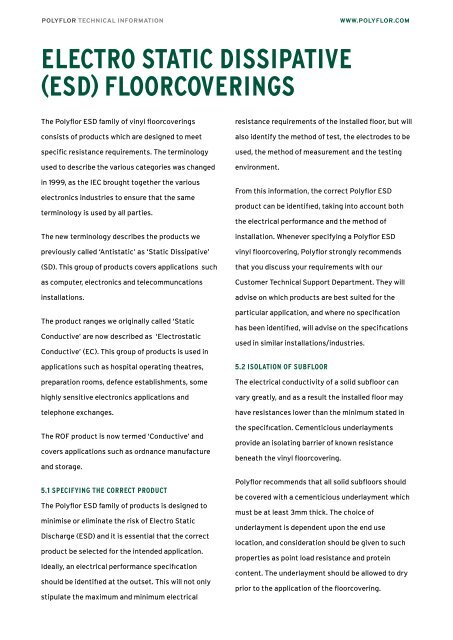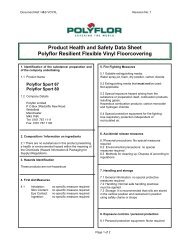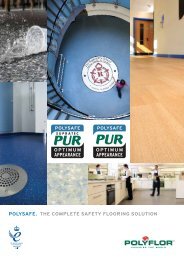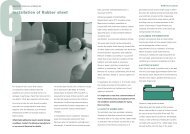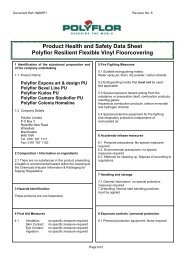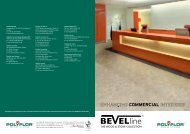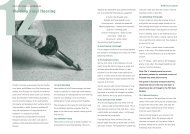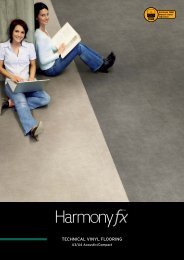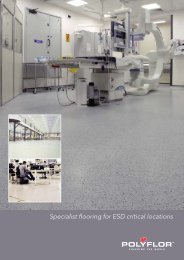floorcoverings - Polyflor
floorcoverings - Polyflor
floorcoverings - Polyflor
You also want an ePaper? Increase the reach of your titles
YUMPU automatically turns print PDFs into web optimized ePapers that Google loves.
POLYFLOR TECHNICAL INFORMATION<br />
WWW.POLYFLOR.COM<br />
ELECTRO STATIC DISSIPATIVE<br />
(ESD) FLOORCOVERINGS<br />
The <strong>Polyflor</strong> ESD family of vinyl <strong>floorcoverings</strong><br />
consists of products which are designed to meet<br />
specific resistance requirements. The terminology<br />
used to describe the various categories was changed<br />
in 1999, as the IEC brought together the various<br />
electronics industries to ensure that the same<br />
terminology is used by all parties.<br />
The new terminology describes the products we<br />
previously called ‘Antistatic’ as ‘Static Dissipative’<br />
(SD). This group of products covers applications such<br />
as computer, electronics and telecommuncations<br />
installations.<br />
The product ranges we originally called ‘Static<br />
Conductive’ are now described as ‘Electrostatic<br />
Conductive’ (EC). This group of products is used in<br />
applications such as hospital operating theatres,<br />
preparation rooms, defence establishments, some<br />
highly sensitive electronics applications and<br />
telephone exchanges.<br />
The ROF product is now termed ‘Conductive’ and<br />
covers applications such as ordnance manufacture<br />
and storage.<br />
5.1 SPECIFYING THE CORRECT PRODUCT<br />
The <strong>Polyflor</strong> ESD family of products is designed to<br />
minimise or eliminate the risk of Electro Static<br />
Discharge (ESD) and it is essential that the correct<br />
product be selected for the intended application.<br />
Ideally, an electrical performance specifıcation<br />
should be identifıed at the outset. This will not only<br />
stipulate the maximum and minimum electrical<br />
resistance requirements of the installed floor, but will<br />
also identify the method of test, the electrodes to be<br />
used, the method of measurement and the testing<br />
environment.<br />
From this information, the correct <strong>Polyflor</strong> ESD<br />
product can be identifıed, taking into account both<br />
the electrical performance and the method of<br />
installation. Whenever specifying a <strong>Polyflor</strong> ESD<br />
vinyl floorcovering, <strong>Polyflor</strong> strongly recommends<br />
that you discuss your requirements with our<br />
Customer Technical Support Department. They will<br />
advise on which products are best suited for the<br />
particular application, and where no specifıcation<br />
has been identifıed, will advise on the specifıcations<br />
used in similar installations/industries.<br />
5.2 ISOLATION OF SUBFLOOR<br />
The electrical conductivity of a solid subfloor can<br />
vary greatly, and as a result the installed floor may<br />
have resistances lower than the minimum stated in<br />
the specifıcation. Cementicious underlayments<br />
provide an isolating barrier of known resistance<br />
beneath the vinyl floorcovering.<br />
<strong>Polyflor</strong> recommends that all solid subfloors should<br />
be covered with a cementicious underlayment which<br />
must be at least 3mm thick. The choice of<br />
underlayment is dependent upon the end use<br />
location, and consideration should be given to such<br />
properties as point load resistance and protein<br />
content. The underlayment should be allowed to dry<br />
prior to the application of the floorcovering.
POLYFLOR TECHNICAL INFORMATION<br />
WWW.POLYFLOR.COM<br />
<strong>Polyflor</strong> accepts no responsibility for non-conformance<br />
due to the resistance of the installed floor being<br />
below the minimum specified, if an isolating barrier<br />
has not been used.<br />
Note: Suspended timber subfloors are not<br />
conductive and do not require an isolating barrier.<br />
5.3 CONDUCTIVE ADHESIVES<br />
<strong>Polyflor</strong> recommends the use of <strong>Polyflor</strong> P30 conductive<br />
adhesive for all Static Control <strong>floorcoverings</strong> and<br />
<strong>Polyflor</strong> P25 contact adhesive for earthing strips.<br />
If alternative adhesives are used, they must be<br />
recommended by the adhesive manufacturer and<br />
approved by <strong>Polyflor</strong>.<br />
Note: Access panels vary from manufacturer to<br />
manufacturer, both in design, materials used and<br />
electrical performance specification. We recommend<br />
in these instances that you discuss your individual<br />
floorcovering.<br />
When an earthing system is installed, <strong>Polyflor</strong><br />
recommends the use of at least two connections to<br />
earth, the second as a security back-up should the<br />
first be disconnected or damaged. Connection of the<br />
earthing system to the building earth is normally<br />
carried out by a qualified electrician and not the<br />
flooring contractor.<br />
5.4.1 <strong>Polyflor</strong> Static Dissipative (SD)<br />
Floorcoverings<br />
If conductance to earth is specifıed, the earth strip is<br />
laid 150mm from one side of the room, in the same<br />
direction as the vinyl sheets are to be laid. This strip<br />
is connected to a known earth (Figure 19).<br />
EARTH<br />
150mm<br />
APPROX<br />
EARTH<br />
STRIP<br />
requirements with your panel supplier or alternatively<br />
with our Customer Technical Support Department.<br />
5.4 CONDUCTANCE TO EARTH<br />
Installing an earthing system is a prerequisite of all<br />
floors, if the specifıcation stipulates a resistance to<br />
earth requirement. It is mandatory for all<br />
“Conductive” floor installations. In our experience,<br />
it is beneficial to install an earthing system for all<br />
<strong>Polyflor</strong> ESD <strong>floorcoverings</strong>. Primarily, this gives the<br />
end user the option to test to earth should there be a<br />
requirement at a later stage. Secondly, it improves<br />
the conductance of the installed floor to a known<br />
earth via a controlled path.<br />
Figure 19 Earthing strip layout<br />
20 METRES 20 METRES<br />
A second strip is laid at 90º to the fırst, 150mm from<br />
the edge and running across the full width of the<br />
room. Further strips are laid at 20 metre intervals as<br />
determined by the size of the room.<br />
5.4.2 <strong>Polyflor</strong> Electrostatic Conductive (EC)<br />
Floorcoverings<br />
150mm<br />
APPROX<br />
If conductance to earth is specifıed, then a length of<br />
earth strip is adhered to the isolating underlayment<br />
and connected to a known earth. The strip need only<br />
BRASS FOIL STRIP<br />
The choice of material used for the earthing system<br />
EARTH<br />
can be brass, copper or stainless steel and should be<br />
nominally 50mm wide and 0.1mm thick. However, the<br />
width is only important for the “Conductive”<br />
Figure 20 Earth connection<br />
150mm<br />
MIN
POLYFLOR TECHNICAL INFORMATION<br />
WWW.POLYFLOR.COM<br />
extend along the floor for 150mm (Figure 20).<br />
5.4.3 <strong>Polyflor</strong> Conductive Floorcoverings<br />
With this type of flooring, an earthing grid of the<br />
correct size strip (50mm wide, 0.1mm thick) is<br />
essential. The strip is laid 150mm from one side of<br />
the room and is connected to a known earth (Figure<br />
21). A second strip is laid at 90° to the fırst strip,<br />
When the adhesive is tacky, the vinyl sheet should be<br />
accurately re-laid, ensuring it does not twist or trap<br />
air bubbles. Seams must be without gaps and any<br />
excess adhesive should be removed as work<br />
proceeds. The vinyl sheet is then rolled with a 68kg<br />
articulated floor roller in the short direction fırst,<br />
then the long, and the rolling repeated between one<br />
and four hours later.<br />
EARTH<br />
GRID SPACING<br />
150mm<br />
600mm<br />
APPROX<br />
Figure 21 Earthing strip layout<br />
150mm<br />
APPROX<br />
EARTH<br />
5.5.2 ESD Vinyl Tiles<br />
<strong>Polyflor</strong> ESD vinyl tiles are installed by the same<br />
method as standard vinyl tiles – the single stick<br />
method. The grid layout for static control tiles is the<br />
same as for sheet vinyl, as described previously.<br />
across the full width of the room, and 150mm from<br />
the edge of the room. Further strips are laid in a<br />
rectangular grid, 600mm apart, as shown on<br />
figure 21. It is important that the layout of the<br />
grid is confirmed with the end user as there are<br />
variations in the requirement for some military<br />
specifications.<br />
5.5 INSTALLATION METHODS<br />
The basic techniques for installation of <strong>Polyflor</strong> ESD<br />
<strong>floorcoverings</strong> are the same as described for<br />
standard vinyl sheet and tile in Sections 3 and 4<br />
respectively. However, there are a number of<br />
important differences:<br />
5.5.1 ESD Vinyl Sheet<br />
<strong>Polyflor</strong> ESD vinyl sheet should be installed by the<br />
double drop method. This is because the conductive<br />
adhesive contains carbon, which results in low tack.<br />
Once the adhesive has been spread, the vinyl sheet<br />
is laid into it and pressed all over to ensure an even<br />
transfer of adhesive. The vinyl sheet is then folded<br />
Note: ESD vinyl tiles must always be heat welded.<br />
See Section 8.<br />
5.6 SPECIAL PRECAUTIONS<br />
Special precautions must be taken with the following<br />
products:<br />
5.6.1 Electrostatic Conductive (EC) Floorcoverings<br />
Pipes or metal projections (e.g. metal gullies, door<br />
spring plates etc.) must be insulated from the EC<br />
floorcovering and free from conductive adhesive.<br />
The following method of installation is recommended.<br />
The EC floorcovering should be cut 50mm short of<br />
any pipe or metal fixture. This infill area should be<br />
laid with a suitably coloured standard <strong>Polyflor</strong> sheet<br />
vinyl, adhered with a non-conductive adhesive.<br />
This infill piece should then be welded to the ESD<br />
floorcovering with a standard weld rod.<br />
5.6.2 Conductive Floorcovering<br />
It is recommended that, as a permanent record, a<br />
brass plate be countersunk into the floor in a suitable<br />
position. The plate should be engraved as follows:<br />
back and left until the adhesive becomes tacky.
POLYFLOR TECHNICAL INFORMATION<br />
WWW.POLYFLOR.COM<br />
<strong>Polyflor</strong> Conductive<br />
Laid by:<br />
Date:<br />
These brass plates are available from the Customer<br />
Technical Support Department at <strong>Polyflor</strong><br />
<strong>Polyflor</strong> Conductive does not provide protection<br />
from a short circuit on a 240/250 volt mains. Where<br />
this material is installed, all electrical equipment and<br />
switches must be located outside the building.<br />
No portable electrical tools should be used inside,<br />
unless earth leakage circuit breakers are fıtted to<br />
the switchgear.<br />
5.8.1 Test Procedure<br />
The electrical testing of the floor must be carried out<br />
with an insulation tester, operating at 100 volts D.C.<br />
5.8.2 Test Electrodes<br />
The electrode consists of a brass cylinder 65 mm in<br />
diameter, weighing approximately 2.5 kg. A screw<br />
connector attaches the test lead to the top surface<br />
of the cylinder. On the underside is attached a round<br />
rubber pad – of 5mm thickness and 65 mm in<br />
diameter – which has been covered with thin metal<br />
foil (Figure 22).<br />
5.7 HEAT WELDING<br />
All <strong>Polyflor</strong> ESD floorcovering installations (excluding<br />
access panels) must be heat welded. Ideally, the floor<br />
should be left for a minimum of 24 hours before<br />
welding the joints. This will prevent adhesive<br />
bubbling up into the seams when heat is applied.<br />
For details of heat welding, see Section 8.<br />
Note: Conductive welding rod is not a requirement<br />
with <strong>Polyflor</strong> ESD <strong>floorcoverings</strong>.<br />
BRASS<br />
FOIL<br />
5.8 TEST METHODS<br />
Worldwide, there are a great many test methods for<br />
electrical grade <strong>floorcoverings</strong> and, with rapid<br />
developments in the electrical and electronic<br />
industries, standards are constantly being reviewed.<br />
To ensure that the floor is tested to the latest<br />
specifıcation, it is suggested that the architect or<br />
specifier should obtain a copy of the test method<br />
and requirements from the local office of the<br />
National Standards Authority. It should then be<br />
attached to the specifıcation prior to the ordering of<br />
materials and installation of the floor. If a test<br />
method is not specifıed, the following procedure is<br />
recommended and approved by <strong>Polyflor</strong>.<br />
Figure 22 Test electrode<br />
5.8.3 Test Conditioning<br />
It is essential to condition the floor prior to testing.<br />
The floor should be cleaned (see Section 19.10) at<br />
least 24 hours before testing, and then conditioned<br />
for 24 hours at 40-60% RH and 20-25°C.<br />
Note: The relative humidity and temperature are<br />
only critical for <strong>Polyflor</strong> Static Dissipative<br />
<strong>floorcoverings</strong>.<br />
5.8.4 Test Method<br />
One electrode should be placed on the floor. The<br />
second connection should be made to the earth<br />
point, the resistance being measured between the
POLYFLOR TECHNICAL INFORMATION<br />
WWW.POLYFLOR.COM<br />
electrode and a known earth. One test should be<br />
made for every 2 square metres of flooring. The test<br />
may not be reliable if made within 24 hours of the<br />
flooring being laid or cleaned.<br />
5.8.5 Testing to a Grid<br />
The procedure of always testing the same points “on<br />
a grid” is not recommended. The whole floor should<br />
meet the specifıcation, not just selected points.<br />
To ensure continual performance of the whole floor,<br />
it should be periodically tested at random points.<br />
5.8.6 Test Results<br />
5.9 STATIC CONTROL SYSTEMS<br />
In many instances, a <strong>Polyflor</strong> ESD floorcovering is<br />
suffıcient to give the necessary control, but in highly<br />
static-sensitive areas, additional precautions may be<br />
necessary. These include:<br />
Dissipative clothing and footwear<br />
Wrist and heel straps<br />
Special work stations<br />
Dissipative packaging and sealing<br />
Ionisers and humidity controllers<br />
<strong>Polyflor</strong> ESD <strong>floorcoverings</strong> are manufactured to<br />
specific levels of conductance and are tested, prior<br />
to despatch, in laboratory conditions.<br />
On-site testing not only takes into account the<br />
floorcovering but also the adhesive, the subfloor and<br />
the environment. When installed and tested in<br />
accordance with the instructions laid down by<br />
<strong>Polyflor</strong> and detailed in this manual, the electrical<br />
resistance should be as follows:<br />
EARTH TEST RESULTS<br />
MINIMUM AVERAGE MAXIMUM AVERAGE<br />
Static Dissipative 1 x 10 6 ohms 1 x 10 9 ohms<br />
Electrostatic Conductive 5 x 10 4 ohms 2 x 10 6 ohms<br />
Conductive ROF Zero ohms 5 x 10 4 ohms<br />
The Customer Technical Support Department offers,<br />
for a fee, a fınished installation testing service – to<br />
ensure that the whole installation meets the<br />
specifıcation requirements. A Certificate of<br />
Conformance is issued on completion. We recommend<br />
that you discuss your testing requirements with our<br />
Customer Technical Support team, to ascertain staff<br />
availability etc.<br />
February 2004


